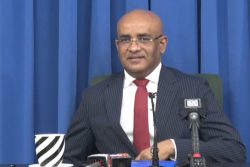The production of potatoes sufficient to meet consumer demand could still be as many as “three to five years away,” despite the considerable success of field trials up to this time.
In the course of a briefing exercise on the progress of the national initiative to boost potato production earlier this week, Chief Executive Officer of the National Agricultural Research & Extension Institute (NAREI), Dr. Oudho Homenauth told the Stabroek Business that while field trials were proceeding satisfactorily the local potato cultivation initiative was still focused on arriving at a determination regarding those varieties that were most suitable for tropical conditions.
While there has been a considerable measure of excitement at official levels as well as in the farming community over the prospects of Guyana becoming self-sufficient in potatoes, NAREI, Homenauth says, is itself focused on ensuring that farmers, apart from buying in to the idea of adding potatoes to the country’s agricultural base receives the support that allows them to understand the techniques associated with realizing the envisaged success. Contextually, the NAREI Head told this newspaper that one of the challenges that interior farmers are likely to face, the potential for the successful cultivation of potatoes in those region notwithstanding, could be cost and logistical considerations associated with moving produce to coastal markets. The traditional role of potatoes as part of the local diet has, over time, been accentuated by its potential arising out of the rise of the ‘fries’ craze associated with the local fast foods industry as well as the role that potatoes continue to play in the broader diversification of the local culinary culture.
Much of the renewed focus on potato cultivation in Guyana can be attributed to the efforts of the Canadian-funded (CAN)$20 million Caribbean regional Promotion of Regional Opportunities for Produce through Enterprises and Linkages (PROPEL) project designed to assess the suitability of local conditions for Irish potato cultivation.
Homenauth, meanwhile, is of the view that while Guyana is still some distance away from realizing the estimated 5,000-odd tonnes annual potato consumption in Guyana, the initiative had already met with a level of success that warrants a significantly enhanced promotion designed to raise public awareness of the commodity’s significant breakthrough on the local agricultural landscape. Accordingly, Homenauth said that NAREI would be working with the Ministry of Agriculture to ensure the illumination of ‘the potato story’ during Agriculture Month this year. Additionally, he said that more emphasis will be placed on tasting and other potato-related public events targeting local consumers.










